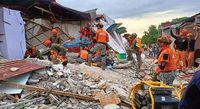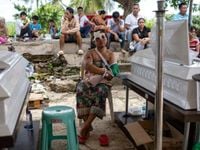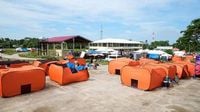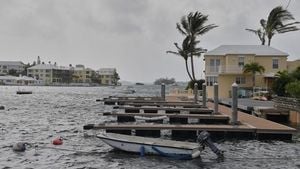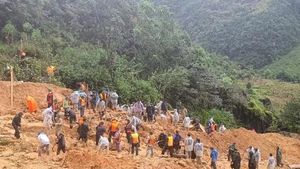As dusk settled over northern Cebu on September 30, 2025, the ground began to shake with a force that left the region reeling. A powerful magnitude 6.9 earthquake struck off the coast of Bogo City at 9:59 p.m., sending shockwaves through the central Philippines and shattering the calm of an otherwise ordinary Tuesday night. The Philippine Institute of Volcanology and Seismology (PHIVOLCS) later confirmed the quake’s shallow depth—just 10 kilometers below the surface—an ominous detail that helped explain the devastation that followed.
According to the National Disaster Risk Reduction and Management Council (NDRRMC), the death toll has now reached 72, with search operations officially completed and no missing persons reported. Rescue teams, working through the night, recovered the last three bodies from a collapsed hotel in Bogo City, near the quake’s epicenter. The province of Cebu, home to nearly three million people, has been left in shock, with more than 170,000 residents affected and over 20,000 displaced, many of whom are still too traumatized to return to their homes.
The impact of the quake was felt hardest in Bogo City, a bustling coastal hub of 90,000 residents. Here, 30 of the confirmed fatalities occurred, with other deaths reported in San Remigio, Medellin, Tabogon, Sogod, and Tabuelan, as detailed by the Office of Civil Defense and Anadolu Agency. The destruction was widespread: 87 buildings and nearly 600 houses were either damaged or destroyed, and critical infrastructure did not escape unscathed. Bridges and concrete roads suffered cracks and collapses, while a seaport in Bogo gave way entirely—an image that has come to symbolize the region’s vulnerability.
One of the most tragic incidents unfolded at a sports complex in northern Cebu, where a basketball game was underway. The building collapsed mid-game, causing multiple casualties, including three coast guard personnel, a firefighter, and a child, as reported by local town officials. The quake also partially destroyed the St. Peter and Paul Church on Bantayan Island and a popular fast-food chain in Bogo, further underscoring the breadth of the destruction.
In the immediate aftermath, hospitals in northern Cebu were pushed beyond their limits. Emergency medical teams from neighboring provinces rushed to assist, but the sheer number of injured—nearly 300 people, according to disaster officials—meant that many patients were treated in makeshift tents outside damaged medical facilities. Saia Ma’u Piukala, Regional Director of the World Health Organization (WHO) Western Pacific Office, described the situation bluntly: “Hospitals report being overwhelmed with the injured.” He added, “Our WHO Philippines Country Office is there to support the Government-led health response in whatever way is needed.”
The government’s response was swift. President Ferdinand Marcos Jr. visited Bogo on October 2, promising both immediate and longer-term relief. During his tour of the disaster zone, he announced plans for a “tent city” to house those displaced from the 600 homes reduced to rubble and thousands more too fearful to sleep indoors as aftershocks continued. “We will build a tent city that can be put up swiftly and will shield people from rain,” Marcos told reporters, pledging essential utilities and financial aid of 10,000 pesos (about $171) to every family that lost their home. He also committed to restoring electricity to Bogo by the end of the day, a lifeline for a city of 90,000 now plunged into darkness.
For many, the terror didn’t end when the ground stopped shaking. More than 340 aftershocks, some reaching up to magnitude 4.8, have rattled the region since the main quake, keeping nerves frayed and sleep elusive. Eighteen-year-old Diane Madrigal, sheltering in a village chapel now repurposed as emergency housing, summed up the anxiety: “I am still scared of the aftershocks up to now; it feels like we have to run again.” Water and basic necessities remain in short supply, with residents like Lucille Ipil lamenting, “The earthquake really ruined our lives. We cannot eat, drink or bathe properly.”
Humanitarian agencies have mobilized in force. The United Nations Office for the Coordination of Humanitarian Affairs (OCHA) praised the “deepest sympathies and unwavering solidarity” of first responders, medical workers, and volunteers. Relief organizations are distributing hygiene kits, water filtration units, and emergency shelter materials. The UN’s International Organization for Migration (IOM) stands ready to support displaced families, while government engineers have worked to ensure that critical hospital buildings are safe for patients to return indoors.
Schools and public buildings have not been spared. Classes were suspended across much of Cebu as officials assessed the safety of structures and cleared debris. The Pacific Tsunami Warning Center issued a warning shortly after the quake, advising residents to avoid coastlines in Cebu, Leyte, and Biliran due to the risk of waves up to three feet. Thankfully, the threat never materialized, and the warning was lifted after three tense hours.
The disaster struck just one week after two deadly typhoons battered the Philippines, compounding the misery for a nation already reeling from nature’s fury. The Philippines sits atop the Pacific “Ring of Fire,” a volatile zone notorious for frequent earthquakes, volcanic eruptions, and typhoons. As Regional Director Piukala of WHO noted, “The Philippines and many of our other 37 countries and areas are vulnerable to earthquakes and other disasters as a consequence of geography and, increasingly, the climate crisis,” calling for continued investment in preparedness.
For Cebu’s residents, the road to recovery will be long and arduous. More than 110,000 people across 42 communities are expected to need assistance rebuilding homes and restoring livelihoods. The government and humanitarian partners are bracing for a massive relief and reconstruction effort, even as aftershocks continue to unsettle daily life. The quake, triggered by a shallow undersea fault that Filipino seismologists say had not moved in 400 years, serves as a stark reminder of the region’s precarious position along the Philippine Sea Plate—a part of the world where the earth’s restlessness is both a fact of life and a persistent threat.
As the dust settles and the last of the rescue teams demobilize, the people of Cebu are left to pick up the pieces. Their resilience, tested by both nature and circumstance, will be the foundation on which the province rebuilds. For now, the scars—physical and emotional—remain fresh, but the commitment of local communities, government, and the international community offers a glimmer of hope amid the devastation.
